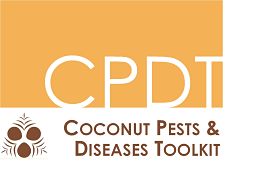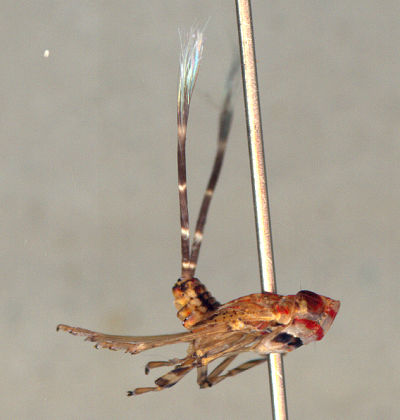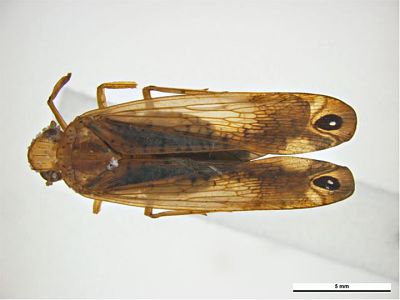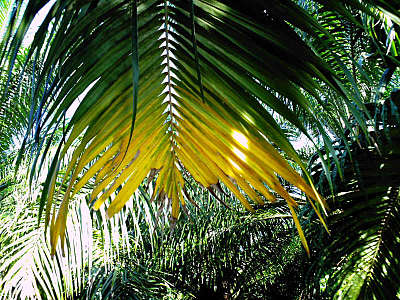Finschhafen disorder
Finschhafen disorder is considered a major disorder in coconut and oil plantations but is restricted to Papua New Guinea (PNG). This is a HIGH risk disease if it should spread elsewhere.
Common name of the disorderFinschhafen disorder |
Scientific name of the cause of the disorderZophiuma butawengi |
on this page: Life-cycle and identification : Symptoms : Impacts : Distribution : Prevention : Controlling Finschhafen disorder : Information sources and further reading
Life-cycle and identification
Finschhafen disorder is caused by the direct feeding of the palm planthopper, Zophiuma butawengi (previously named Zophiuma lobulata). Zophiuma butawengi is a planthopper insect that feeds on the fronds of coconut palms. This planthopper lays eggs that then go through 5 nymphal stages until it reaches adult form in about 12 weeks.
The disorder is named after the Finschhafen area in PNG, from where it was first reported in 1960.
It is thought that the symptoms arise from a toxic reaction to planthopper feeding. The disorder can affect all ages of palms.
EggsZophiuma butawengi planthopper eggs are laid near the base of leaflets or petiole (the stalk that joins a leaf to a stem) or underside of leaflets. The eggs are a pale green colour, have an ovoid (rounded) shape, and measure 2 mm by 1 mm. They are covered in a white woolly substance. Egg masses vary in size from 1-300 eggs. NymphsZophiuma butawengi planthoppers have five nymphal stages. The nymphs have waxy thread-like structures extending from the end of their body (abdomen). They also have two red bands across their front and another set along their sides. The first nymphal stage stays near the original egg laying site and later moves to older fronds. The five stages last about 12 weeks in total. AdultsAdult Zophiuma butawengi planthoppers are brownish in colour. They have distinctive white spots circled with black at the end of their wings. The adult planthoppers are 16-18 mm in length. |
Nymph Zophiuma butawengi (© Ken Walker, PaDIL)
Adult Zophiuma butawengi (© Ken Walker, PaDIL) |
Symptoms
|
The main symptom of Finschhafen disorder is early signs of ageing of the leaves. The leaflets change from green to a yellow-bronze. This colour change starts at the tip of the leaf and moves down the leaf to meet the stem. Fronds curve downwards. The leaflets die off from the tips as the colour change moves along the leaf. Older fronds are affected first. However the disease does not spread from one leaf directly to the leaf next to it. Rather it spreads slowly and infects apparently random fronds. This probably reflects the feeding patterns of the planthopper. Fronds will also curve down more and die earlier when symptoms are severe. |
Yellowing and following death of leaflets from the tip of the affected frond (© Geoff Gurr, Charles Sturt University) |
Nut production is also reduced, and stunting of palm growth has been observed.
The symptoms can occur at different rates depending on the number of planthoppers (abundance of the insect). For example 100 planthoppers on one frond can cause symptoms that start to appear between 3-12 months.
Yellowing of leaves may be misdiagnosed as normal yellowing due to dry weather, nutritional deficiencies and other insect damage. Other causes, such as nutritional deficiencies and plant diseases also result in yellowing of leaves on coconut palms. These include Bogia coconut syndrome and lethal yellowing.
If yellowing occurs on palms they should be observed for acceleration of yellowing from the tips of fronds, to confirm Finschhafen disorder is the cause, rather than a plant disease or nutritional deficiency.
Visual inspection may reveal Zophiuma butawengi planthoppers if they are present.
Impacts
Where there is a high percentage (80-90%) of yellowing, nuts may be dropped before harvest.
Where there have been outbreaks, up to 80% of palms can be affected with 10% of them dying. This can equal a third of the crop lost.
Currently Papua New Guinea coconut production is under threat in Milne Bay and the Northern Province, with some outbreaks larger than 100 ha.
Distribution
Finschhafen disorder has a narrow distribution. Reports have been limited to the Morobe to Milne Bay Provinces coastal and west New Britain in Papua New Guinea.
Please check with your local biosecurity / quarantine or SPC for up-to-date distribution information.
Prevention
Most importantly, the International Guidelines for transfer of coconut germplasm should be strictly followed to prevent pests and diseases being moved to new locations.
Prevention involves restricting the spread of the insects that cause the disorder, and limiting their abundance.
However, it is uncertain how outbreaks arise and what keeps the number of insects low under normal circumstances.
For general information on preventing pests and diseases of coconut, see the Prevention section.
Controlling Finschhafen disorder
Affected coconut palms can recover and start to produce healthy fronds again if symptoms are caught early and planthopper populations controlled.
We strongly recommend an integrated pest management (IPM) approach to the control of all insects, where possible. This is a combination of methods (pesticides, physical controls such as site hygiene, and biological controls) to minimise the use of pesticides and minimise the cost of control.
Integrated Pest Management
The goal of IPM is to keep pest populations to a level below which that are doing harm. IPM involves using multiple control options together for the economic control of pests (i.e. cultural, natural and chemical). In an agricultural context the Food and Agriculture Organization defines IPM as "the careful consideration of all available pest control techniques and subsequent integration of appropriate measures that discourage the development of pest populations and keep pesticides and other interventions to levels that are economically justified and reduce or minimize risks to human health and the environment. IPM emphasizes the growth of a healthy crop with the least possible disruption to agro-ecosystems and encourages natural pest control mechanisms".
Cultural
Insect proofing of healthy fronds may help reduce the spread of the disorder by reducing planthopper breeding and feeding sites.
Natural
Biological control agents include generalist predators for Zophiuma butawengi. Wasps that are egg parasitoids (Parastethynium maxwelli and Ooencyrtus isabellae) have been observed to parasitise 25 - 75% of egg masses in the field.
Fungi such as Metarhizium species may also be a good control method as it has been effective on other Zophiuma species. Metarhizium can be purchased in bulk online at websites such as alibaba.com.
Chemical
Systemic insecticides have been used to control Zophiuma butawengi planthopper when damage is considerable and an outbreak is a major threat to production. These are administered via in trunk injections. The insecticide used - an organophosphate: methamidophos - is considered highly hazardous by the World Health Organisation and is not recommended. We strongly advise against using any organophospate pesticides.
If insecticides are to be used, it is preferable to use synthetic pyrethroids.
Information sources and further reading
Howard, Giblin-Davis, Moor, Abad. 2001. Insects on palms. CABI. pp. 156.
Page. 2004. Finschhafen disorder in oil palms. Its symptoms, causal agent, current knowledge and control. The OPRAtive word, Technical note 5. [ONLINE]
PestNet. 2017. Coconut Finschhafen disorder. [ONLINE]
Smith. 1980. Zophiuma lobulata ghauri (Homoptera: lophopidae) and its relation to the Finschhafen coconut disorder in Papua New Guinea. Papua New Guinea Agricultural Journal, 31, 1-4, pp. 37-45.
content reviewed by Disna Gunawardana, Plant Health and Environment Laboratory, Ministry of Primary Industries, New Zealand, November 2018



